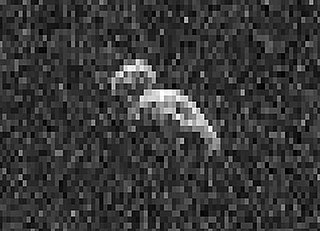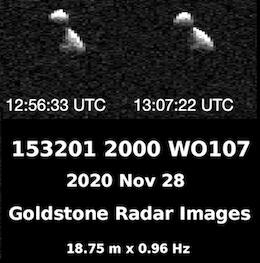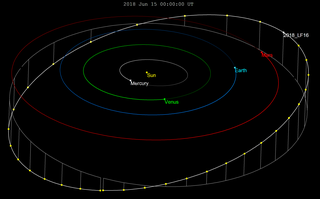(89959) 2002 NT7 (prov. designation:2002 NT7) is a near-Earth object with a diameter of 1.4 kilometers and potentially hazardous asteroid of the Apollo group. It has a well determined orbit with an observation arc of 64 years including precovery images by Palomar Observatory dating back to 1954.

(4953) 1990 MU is a large Earth-crossing asteroid (ECA) belonging to the Apollo group of near-Earth objects which also cross the orbits of Mars and Venus. At approximately 3 km in diameter, it is one of the largest known ECAs. It has been assigned a permanent number from the Minor Planet Center (4953) indicating that its orbit has been very well determined. With an observation arc of 45 years, the asteroid's trajectory and uncertainty regions are well known through to the year 2186.
(153814) 2001 WN5 is a sub-kilometer asteroid, classified as near-Earth object and potentially hazardous asteroid of the Apollo group.
(7888) 1993 UC is a near-Earth minor planet in the Apollo group. It was discovered by Robert H. McNaught at the Siding Spring Observatory in Coonabarabran, New South Wales, Australia, on 20 October 1993. The asteroid has an observation arc of 23 years and has a well determined orbit. Its estimated size is 2.3 to 5.2 km.
(529366) 2009 WM1, provisional designation 2009 WM1, is a sub-kilometer asteroid and near-Earth object of the Apollo group, approximately 280 meters (920 feet) in diameter. After its discovery by the Catalina Sky Survey at the Catalina Station in Arizona, United States, this potentially hazardous asteroid was briefly listed at a Torino Scale of 1 and a cumulative Palermo Scale of −0.87. It was removed from the Sentry Risk Table on 26 June 2013.
2010 XC15 (also written 2010 XC15) is an Aten near-Earth asteroid and potentially hazardous object that spends most of its time inside of the orbit of Earth. It has an observation arc of 10 years and an Uncertainty Parameter of 1. It was discovered on 5 December 2010 by the Catalina Sky Survey at an apparent magnitude of 17.5 using a 0.68-metre (27 in) Schmidt.
(612358) 2002 JE9 (also written 2002 JE9) is an Apollo near-Earth asteroid and potentially hazardous object. It has a well determined orbit with an observation arc of 10 years and an Uncertainty Parameter of 1. It was removed from the Sentry Risk Table on 10 May 2002. 2002 JE9 was discovered on 6 May 2002 by the Lincoln Near-Earth Asteroid Research (LINEAR) project using a 1.0-metre (39 in) Reflecting telescope; at the time of discovery, the asteroid possessed an apparent magnitude of 19.1.

(308242) 2005 GO21 is a large Aten near-Earth asteroid and potentially hazardous object. It has a well determined orbit with an observation arc of 7 years and an uncertainty parameter of 0. It was discovered on 1 April 2005 by the Siding Spring Survey at an apparent magnitude of 18.1 using the 0.5-metre (20 in) Uppsala Southern Schmidt Telescope.
(85640) 1998 OX4, also written 1998 OX4, is a sub-kilometer asteroid, classified as near-Earth object and potentially hazardous asteroid of the Apollo group.
2003 BR47 is a sub-kilometer asteroid classified as near-Earth object and potentially hazardous asteroid of the Apollo group. It was discovered on 31 January 2003 by the LINEAR program. As of 19 March 2013, its orbit is based on 170 observations spanning a data-arc of 939 days.
2013 ND15 (also written 2013 ND15) is an asteroid that is a temporary trojan of Venus, the first known Venus trojan.

(388188) 2006 DP14, provisional designation 2006 DP14, is a sub-kilometer sized, peanut-shaped asteroid on a highly eccentric orbit, classified as near-Earth object and potentially hazardous asteroid of the Apollo group. This contact binary was discovered on 23 February 2006, by astronomers of the LINEAR program at the Lincoln Laboratory's Experimental Test Site near Socorro, New Mexico, in the United States. On 10 February 2014, it passed 6.25 lunar distances from Earth. The asteroid is approximately 400 meters in diameter and has a rotation period of 5.77 hours.
2015 AZ43 (also written 2015 AZ43) is an Apollo near-Earth asteroid roughly 70 meters in diameter. On 10 February 2015 with a 29.5-day observation arc, it showed a 1 in 5,880 chance of impacting Earth on 27 February 2107. However, the NEODyS nominal best-fit orbit shows that 2015 AZ43 will be 2.8 AU (420,000,000 km; 260,000,000 mi) from Earth on 27 February 2107. A (non-impacting) Earth close approach in 2056 makes future trajectories diverge. It was removed from the JPL Sentry Risk Table on 23 February 2015 using JPL solution 26 with an observation arc of 40 days that included radar data.

(153201) 2000 WO107 is a sub-kilometer asteroid, classified as near-Earth object and potentially hazardous asteroid of the Aten group with a very well determined orbit. It was discovered on 29 November 2000, by astronomers of the Lincoln Near-Earth Asteroid Research (LINEAR) at the Lincoln Laboratory's Experimental Test Site near Socorro, New Mexico, in the United States. It is a contact binary.

2014 JO25 is a near-Earth asteroid. It was discovered in May 2014 by astronomers at the Catalina Sky Survey near Tucson, Arizona - a project of NASA's NEO (Near Earth Object) Observations Program in collaboration with the University of Arizona.

(505657) 2014 SR339, provisional designation 2014 SR339, is a dark and elongated asteroid, classified as near-Earth object and potentially hazardous asteroid of the Apollo group, approximately 970 meters (3,200 feet) in diameter. It was discovered on 30 September 2014, by NASA's Wide-field Infrared Survey Explorer telescope (WISE) in Earth's orbit. Closely observed at Goldstone and Arecibo in February 2018, it has a rotation period of 8.7 hours.

2018 LF16 is a small Mars crossing asteroid roughly 213 m (699 ft) in diameter. It was first observed by astronomers with the Pan-STARRS survey at Haleakala Observatory on 14 June 2018. It was removed from the Sentry Risk Table on 29 July 2021. With an observation arc of 15 years the orbit is very well known and it does not make any notable approaches to Earth.
1979 XB is a lost asteroid with a short observation arc of 3.9 days that cannot be recovered with targeted observations and awaits serendipitous survey observations. It is classified as a near-Earth object and potentially hazardous asteroid of the Apollo group and is estimated to be 660 meters in diameter. The unnumbered minor planet has a poorly constrained orbit and has not been observed in 40 years. It has been listed on the Sentry Risk Table since the list started in 2002. With a cumulative Palermo Technical Impact Hazard Scale of −2.72, the poorly known orbit and assumed size place 1979 XB third on an unconstrained listing of the Sentry Risk Table.

(85990) 1999 JV6, provisional designation 1999 JV6, is a sub-kilometer near-Earth asteroid and a potentially hazardous object of the Apollo group. It was discovered by astronomers of the LINEAR program at the Lincoln Laboratory's Experimental Test Site near Socorro, New Mexico. 1999 JV6 is a contact binary object consisting of two distinct lobes, as seen in radar images from various observatories including Arecibo and Goldstone in January 2015.
2017 MZ8 (also written 2017 MZ8) is a near-Earth object and a potentially hazardous asteroid, meaning that it has an orbit that can make close approaches to the Earth and large enough to cause significant regional damage in the event of impact. It is an Apollo asteroid, meaning that it is an Earth-crossing asteroid that has an orbit larger than the orbit of the Earth. It was first observed on 22 June 2017, when the asteroid was about 1 AU from Earth and had a solar elongation of 131 degrees.










